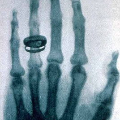项目名称: 医学图像的高容量及鲁棒可逆水印的研究
项目编号: No.61201393
项目类型: 青年科学基金项目
立项/批准年度: 2013
项目学科: 电子学与信息系统
项目作者: 翁韶伟
作者单位: 广东工业大学
项目金额: 24万元
中文摘要: 可逆水印技术为网络环境下的医学图像的版权保护提供一种有效的保护手段。且可逆水印技术能很好满足医学图像不允许失真的特殊要求。近年来,为了解决医学图像的应用局限性,对医学图像的可逆水印在容量和鲁棒性上提出了越来越高的要求。结合医学图像的自身特点,本研究具体包括四个方面 ① 理论研究可逆水印用于医学图像时所能达到的容量上限;② 确定同等失真下携带载荷能力强的区域,提出基于图像统计特性的自适应嵌入策略;③ 以预处理的方式降低嵌入失真来换取容量的提高,提出新的自适应图像的预处理方法;④提出对某些攻击具有不变性的双射的整数不变域(或空域统计不变量及其嵌入方式),提高医学图像的可逆水印的鲁棒性。本项目的研究成果将进一步推动医学图像的可逆水印的理论和算法研究,极大促进可逆水印在医学图像中的实际应用。
中文关键词: 医学图像;高容量;高保真;自适应预测器;局部复杂度
英文摘要: Reversible watermarking works effectively for medical images content authentication by embedding a watermark (such as identification data, serials number, text or image etc.) to medical images without influencing the vision of medical images in network environment. And meanwhile, reversible watermarking can reconstruct the original image without any distortion after the hidden data have been extracted; thus, reversible watermarking is very useful, especially in applications dictating high fidelity of multimedia content, such as medical images. In recent years, higher and higher requirements are raised for embedding-capacity and robustness when reversible watermarking is used for medical images. In combination with self-characteristics of medical images, this project is to study four aspects below: ① the theoretical limits of the capacity are investigated under the condition that the embedding distortions are controlled in a small range when reversible watermarking is used for medical images. ② all the regions being capable of carrying high capacity are obtained, and then the self-adaptive embedding strategy is proposed to self-adaptively embedding as much watermarking information as possible into these regions with high capacity. ③ the key idea of the pre-processing method is to largely increasing the embedding
英文关键词: medical images;high-capacity;high-fidelity;adaptive predictor;local complexity
